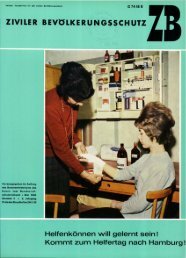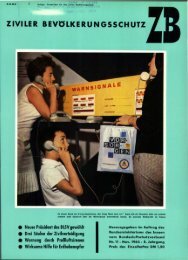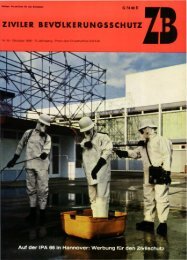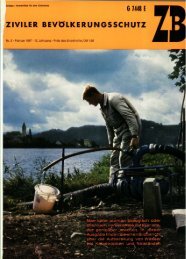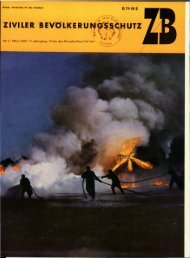Zivilschutz- Forschung - Bundesverwaltungsamt
Zivilschutz- Forschung - Bundesverwaltungsamt
Zivilschutz- Forschung - Bundesverwaltungsamt
Erfolgreiche ePaper selbst erstellen
Machen Sie aus Ihren PDF Publikationen ein blätterbares Flipbook mit unserer einzigartigen Google optimierten e-Paper Software.
109. LeJeune, K. E. and A. J. Russell (1999). „Biocatalytic nerve agent detoxification<br />
in fire fighting foams.“ Biotechnol Bioeng 62(6): 659-65.<br />
110. Leonard, R. B. (1993). „Hazardous materials accidents: initial scene assessment<br />
and patient care.“ Aviat Space Environ Med 64(6): 546-51.<br />
111. Leonard, R. B. (1993). „Hazardous materials accidents: initial scene assessment<br />
and patient care.“ Aviat Space Environ Med 64(6): 546-51.<br />
112. Leonard, R. B., J. J. Calabro, et al. (1989). „SARA (Superfund Amendments<br />
and Reauthorization Act), Title III: implications for emergency physicians.“<br />
Ann Emerg Med 18(11): 1212-6.<br />
113. Leonard, R. B. and U. Teitelman (1991). „Manmade disasters.“ Crit Care<br />
Clin 7(2): 293-320.<br />
114. Li, J. (2001). „A GIS planning model for urban oil spill management.“ Water<br />
Sci Technol 43(5): 239-44.<br />
115. Li, Q., M. Minami, et al. (1998). „Elevated frequency of sister chromatid<br />
exchanges in lymphocytes of victims of the Tokyo sarin disaster and in experiments<br />
exposing lymphocytes to by-products of sarin synthesis.“ Toxicol<br />
Lett 98(1-2): 95-103.<br />
116. Lin, Y. (1989). „Study on environmental health strategy after earthquake.“<br />
Biomed Environ Sci 2(4): 331–4.<br />
117. Lorin, H. G. and P. E. Kulling (1986). „The Bhopal tragedy – what has Swedish<br />
disaster medicine planning learned from it?“ J Emerg Med 4(4): 311-6.<br />
118. Lynch, A. (2001). „An interview with: Alan Lynch on establishing a chemical<br />
decontamination plan for your hospital.“ Hosp Secur Saf Manage 22(1):<br />
12-4.<br />
119. Lyons, K. (1999). „Is your hospital prepared to treat hundreds of victims of<br />
a terrorist attack?“ J Healthc Prot Manage 16(1): 20-4.<br />
120. Lyons, R. A., D. Wright, et al. (2000). „Investigation of an acute chemical<br />
incident: exposure to fluorinated hydrocarbons.“ Occup Environ Med 57(9):<br />
577-81.<br />
121. Mac Sheoin, T. (1986). „Bhopal: a bibliography.“ Int J Health Serv 16(3):<br />
441-68.<br />
122. Macintyre, A. G., G. W. Christopher, et al. (2000). „Weapons of mass<br />
destruction events with contaminated casualties: effective planning for health<br />
care facilities.“ Jama 283(2): 242-9.<br />
123. Maniscalco, P. M., H. T. Christen, et al. (1998). „Terrorism. Part 1: Calibrating<br />
your risks and response.“ J Emerg Med Serv JEMS 23(11): 38-40,<br />
42-4, 46-51.<br />
124. Markowitz, J. S., E. M. Gutterman, et al. (1989). „Acute health effects<br />
among firefighters exposed to a polyvinyl chloride (PVC) fire.“ Am J Epidemiol<br />
129(5): 1023-31.<br />
125. McCunney, R. J. (1996). „Emergency response to environmental toxic incidents:<br />
the role of the occupational physician.“ Occup Med (Lond) 46(6):<br />
397-401.<br />
228










